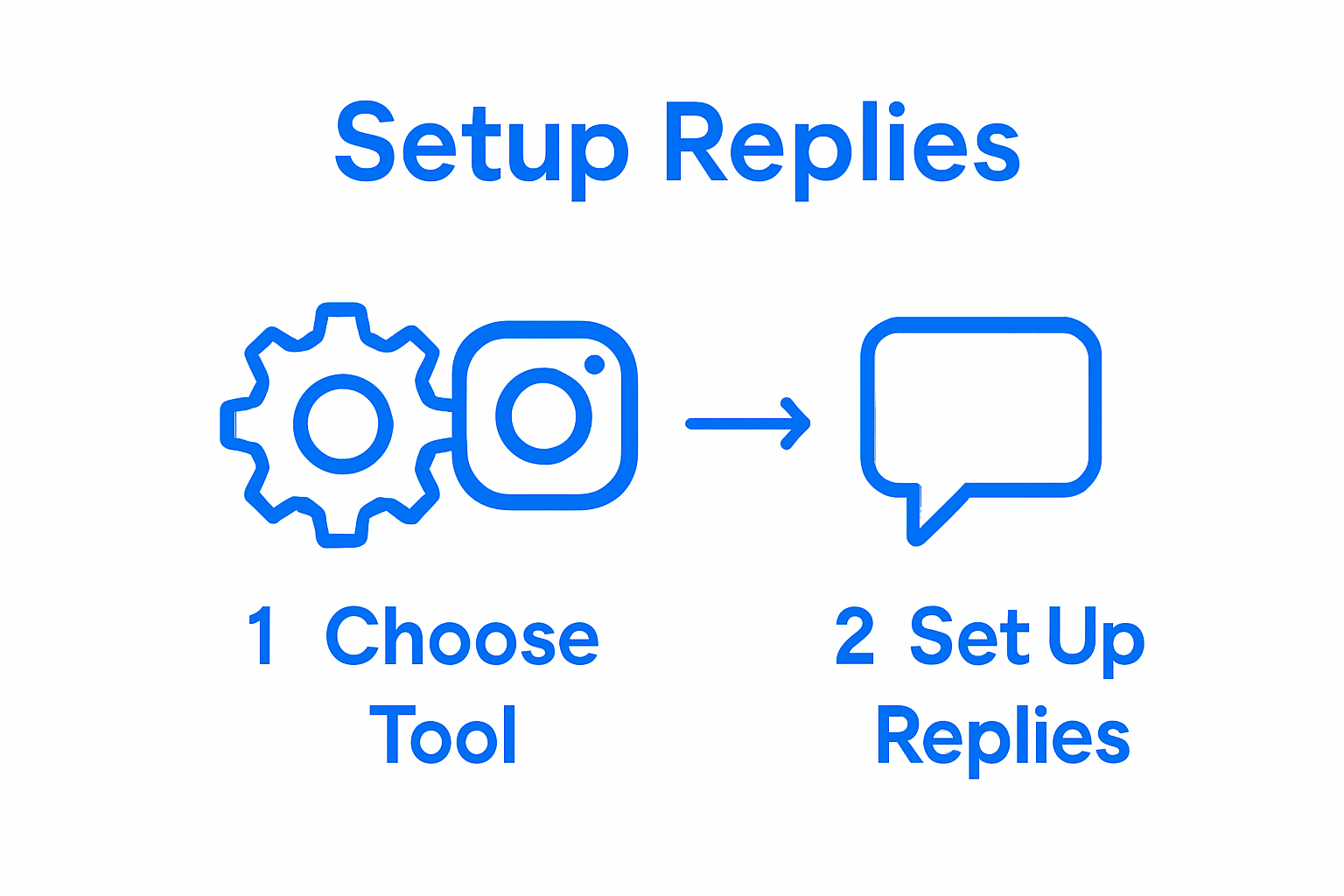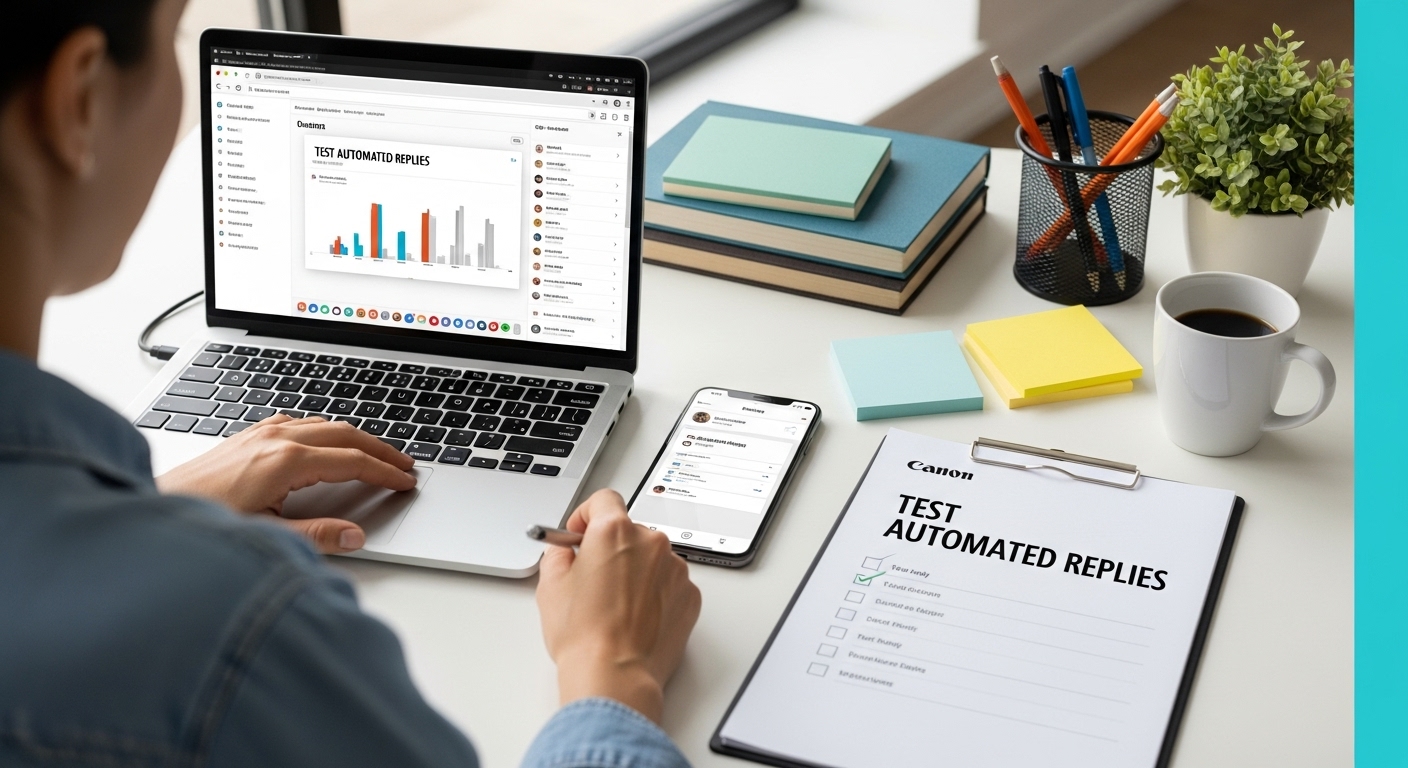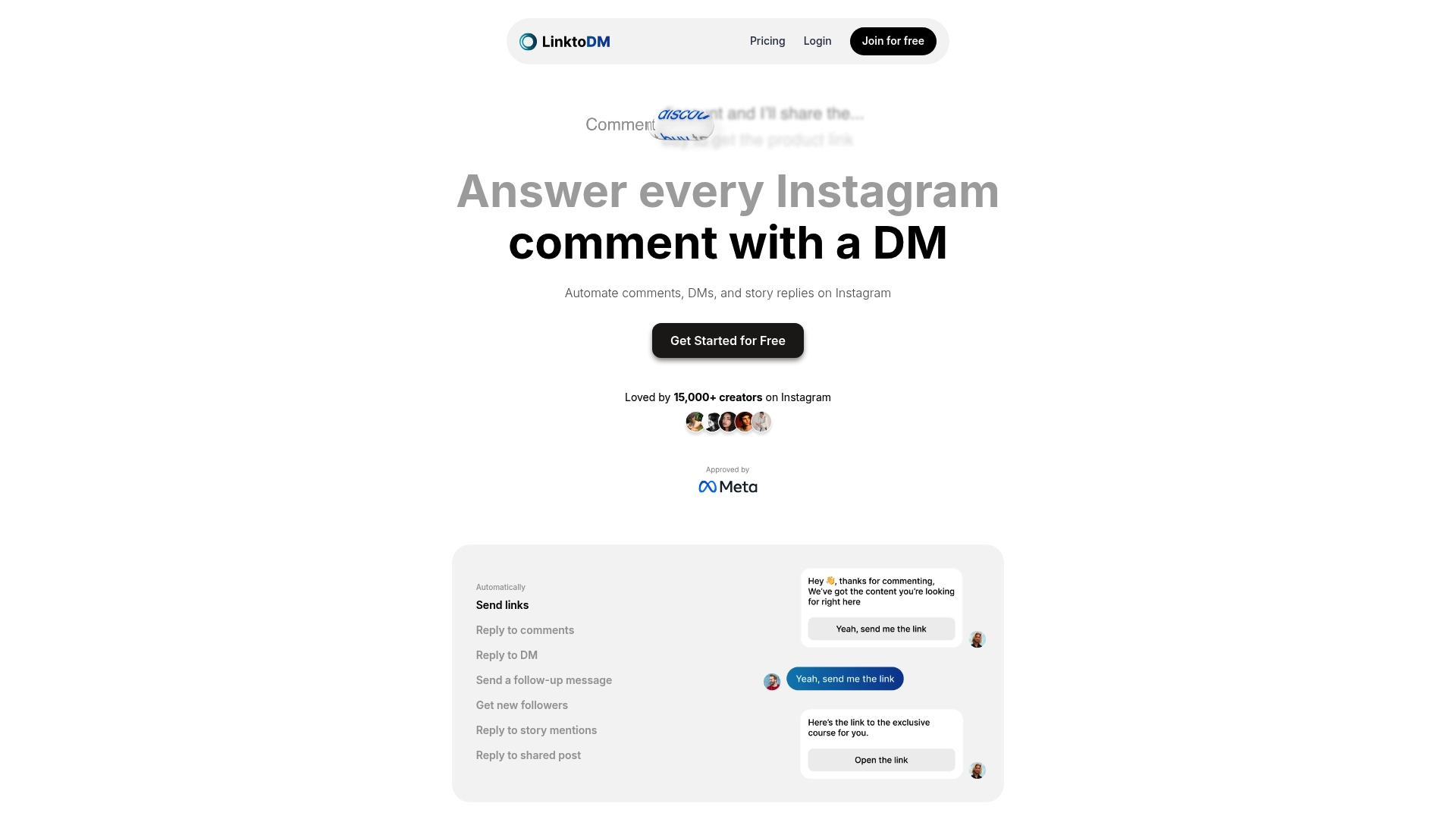How to Automate Instagram Replies for Enhanced Engagement

Instagram reply automation sounds futuristic, but it is already making waves for brands and creators alike. In fact, personalized automated replies can drive up community engagement by more than 30 percent compared to generic responses. Most people guess automation is all about cold, robotic messages. The real secret is well-crafted automation actually builds stronger, more authentic connections and helps followers feel truly heard.
Table of Contents
Quick Summary
| Key Point | Explanation |
| 1. Identify Your Automation Purpose | Define clear communication goals to ensure your automated replies engage effectively with your audience. |
| 2. Choose the Right Automation Tool | Select an Instagram automation tool that aligns with your needs while ensuring compliance with platform policies. |
| 3. Customize Response Templates | Create personalized reply templates that reflect your brand voice and enhance user engagement. |
| 4. Test Automated Replies Thoroughly | Implement rigorous testing of your automated messages to ensure quality and appropriate responses. |
| 5. Continuously Monitor and Adjust | Regularly review and refine your automation strategy based on performance metrics and user feedback. |
Step 1: Identify Your Purpose for Automation
Successful Instagram reply automation starts with crystal clear strategic intent. Your automation approach must align precisely with specific communication goals to transform how you interact with your audience. Without a well-defined purpose, automated replies become generic noise that fails to engage or provide genuine value.
Defining your automation purpose requires a strategic assessment of your Instagram account’s primary objectives. Are you seeking to build community engagement, generate leads, provide customer support, or cultivate a more interactive brand presence? Each goal demands a nuanced automation strategy tailored to your specific audience expectations.
For instance, a personal brand might focus on nurturing follower relationships through personalized acknowledgments, while a business account could prioritize rapid customer inquiry resolution. Some creators leverage automation to maintain consistent communication during high-traffic periods or when managing multiple content channels simultaneously.
To determine your precise automation purpose, conduct a thorough audit of your current Instagram interactions. Analyze comment patterns, message frequency, response times, and audience sentiment. Look for recurring themes or questions that consume significant manual communication effort. Read more about optimizing Instagram engagement strategies to gain deeper insights into strategic automation approaches.
Key considerations when identifying your automation purpose include:
-
Alignment with brand voice and communication style
-
Specific audience interaction goals
-
Measurable engagement metrics you want to improve
-
Types of interactions most suitable for automated responses
Remember that effective automation is not about replacing human connection but enhancing and scaling meaningful interactions. Your automated replies should feel authentic, contextually relevant, and reflective of your unique brand personality. The goal is to create a seamless communication experience that makes followers feel heard and valued, even when responses are partially automated.
Here is a summary of each main step in the Instagram reply automation process, including the goal and what to focus on at each stage.
| Step | Key Goal | Focus Points |
| 1. Identify Purpose | Define clear communication objectives | Align with brand voice, analyze audience needs |
| 2. Choose a Tool | Select a suitable automation platform | Ensure compliance, customize to your workflow |
| 3. Set Up Tool | Configure settings for authenticity | Implement triggers, create response variations |
| 4. Create Templates | Craft personalized reply templates | Maintain brand voice, add personalization elements |
| 5. Test Replies | Ensure quality and effectiveness | Simulate scenarios, monitor audience response |
| 6. Monitor & Adjust | Continuously improve interactions | Analyze metrics, refine strategies |
Step 2: Choose an Automation Tool for Instagram
Selecting the right Instagram automation tool is a critical decision that can dramatically impact your social media engagement strategy. Not all tools are created equal, and finding one that matches your specific needs requires careful evaluation of features, compliance standards, and overall platform compatibility.
When exploring automation solutions, prioritize platforms that offer robust Instagram policy-compliant features. The ideal tool should provide intelligent response mechanisms that sound natural, customize easily to your brand voice, and integrate seamlessly with your existing social media workflow. According to research from academic experts on social media engagement, successful automation hinges on tools that can mimic authentic human interaction while maintaining scalability.
Your automation tool selection process should involve comprehensive feature assessment. Look for platforms offering advanced capabilities like sentiment analysis, customizable response templates, keyword recognition, and real-time engagement tracking. These features ensure your automated replies remain contextually relevant and genuinely helpful to your audience.
Explore our comprehensive guide to Instagram automation tools to understand the nuanced differences between available solutions. Key evaluation criteria should include:
-
Depth of customization options
-
Compliance with Instagram’s terms of service
-
Cost-effectiveness and pricing structure
-
User interface intuitiveness
-
Quality of customer support
Beyond technical specifications, consider the tool’s ability to adapt to your unique communication style. The most effective automation solutions act as an extension of your brand personality, creating seamless interactions that feel authentic and engaging.
 Avoid tools that produce generic, robotic responses that could potentially alienate your followers.
Avoid tools that produce generic, robotic responses that could potentially alienate your followers.
This table organizes essential features to consider when choosing an Instagram automation tool, helping you compare options and identify what best fits your needs.
| Feature | Purpose |
| Instagram Policy Compliance | Ensures automation does not violate platform rules |
| Customizable Templates | Allows replies to match your brand voice |
| Sentiment Analysis | Enables context-aware and emotionally appropriate responses |
| Keyword Recognition | Triggers precise, relevant automated replies |
| Real-time Engagement Tracking | Monitors performance and audience interactions |
| Cost-Effectiveness | Provides value while fitting your budget |
| User-friendly Interface | Streamlines setup and ongoing management |
| Quality Customer Support | Offers help if you encounter issues with the automation tool |
A strategic approach involves testing multiple tools through free trials or limited versions before making a final commitment. This allows you to experience the platform’s capabilities firsthand and determine whether its automation features align with your specific Instagram engagement objectives. Remember, the goal is not complete automation, but intelligent, strategic interaction that enhances your social media presence.
Step 3: Set Up Your Automation Tool for Replies
Configuring your Instagram automation tool requires meticulous attention to detail and a strategic approach to creating responsive, intelligent reply systems. This step transforms your selected tool from a generic platform into a powerful engagement mechanism tailored precisely to your brand’s communication style.
Begin by thoroughly exploring your chosen tool’s settings and configuration options. Authenticity is paramount when setting up automated replies, which means crafting responses that sound natural and reflect your unique brand voice. Take time to develop response templates that feel conversational rather than robotic, ensuring each automated interaction maintains a genuine connection with your audience.
Learn more about configuring AI and manual reply settings to understand the nuanced approaches to creating effective automated responses. Start by mapping out common interaction scenarios your account experiences. These might include welcome messages for new followers, standard responses to frequently asked questions, or acknowledgment messages for specific types of comments.
When developing your automation strategy, implement intelligent triggers that activate specific response types. These triggers could include keyword recognition, comment sentiment analysis, or specific interaction patterns. For instance, you might create separate response protocols for positive comments, customer service inquiries, or general engagement attempts. The goal is to create a responsive system that feels personalized and immediate.
Key configuration considerations include:
-
Defining precise keyword triggers for automated responses
-
Creating multiple response variations to prevent repetitive messaging
-
Setting up fallback mechanisms for complex or unexpected interactions
-
Establishing response time windows that align with your audience’s expectations
Crucial to successful setup is maintaining a balance between automation and human touch. Your tool should enhance communication efficiency without completely removing personal interaction.
Regularly review and refine your automated responses, ensuring they continue to sound authentic and align with your evolving brand communication strategy. Successful configuration means creating a system that feels seamless, responsive, and genuinely engaging to your Instagram audience.
Step 4: Create and Customize Your Response Templates
Crafting compelling response templates is an art form that balances authenticity, efficiency, and strategic communication. Your automated replies must transcend generic interactions, transforming each digital touchpoint into an opportunity for meaningful audience connection. Personalization is the cornerstone of effective template design, requiring a deep understanding of your brand’s unique voice and your audience’s expectations.
Begin by developing a comprehensive inventory of potential interaction scenarios your Instagram account typically encounters. This might include welcome messages for new followers, appreciation responses to positive comments, standard customer service inquiries, and engagement prompts for specific content types. Explore our detailed guide on creating versatile response templates to understand the nuanced approaches to crafting engaging automated interactions.
According to research exploring computational linguistics and user engagement, the most effective response templates incorporate subtle variations in language, emotional tone, and contextual relevance. Avoid repetitive, robotic language by developing multiple template versions that can be dynamically selected based on specific interaction triggers. Consider implementing slight grammatical and structural variations to maintain a sense of spontaneity and genuine interaction.
Your response templates should encompass different emotional registers and communication styles. Key design principles include:
-
Maintaining a consistent brand voice across all automated interactions
-
Creating templates that sound conversational and natural
-
Developing response variations to prevent predictable messaging
-
Incorporating subtle personalization elements
Carefully test and refine your templates through systematic analysis. Monitor audience engagement metrics, track response rates, and be prepared to continuously iterate your approach. The most successful automation strategies treat templates as living documents that evolve with your brand’s communication strategy and audience preferences. Remember that automation should enhance, not replace, genuine human connection. Your goal is to create a responsive, intelligent system that feels personal and immediately relevant to each individual follower.
Step 5: Test Your Automated Replies for Quality
Testing your automated Instagram replies is a critical phase that transforms theoretical configurations into practical, engaging communication strategies. Quality assurance is not an optional step, but a mandatory process to ensure your automation delivers the authentic, responsive experience your audience expects.
Initiate your testing through a systematic, multi-stage approach that simulates real-world interaction scenarios. Create a controlled environment where you can meticulously evaluate each automated response’s performance, tone, and contextual appropriateness. Learn more about comprehensive testing methodologies for social media automation to understand the nuanced techniques for validating your reply system.
According to research examining social media engagement metrics, effective testing goes beyond surface-level evaluation. Develop a comprehensive testing framework that assesses multiple dimensions of your automated replies. This includes analyzing response accuracy, emotional tone, grammatical correctness, and alignment with your brand’s communication style.
Your testing protocol should encompass several strategic approaches:
-
Conducting controlled interaction tests with multiple account types
-
Tracking response time and relevance accuracy
-
Monitoring audience reaction and engagement metrics
-
Implementing periodic manual review of automated interactions
Critical to successful testing is creating diverse test scenarios that challenge your automation’s adaptability. Simulate complex interactions, including comments with nuanced language, mixed sentiments, and industry-specific terminology. Pay close attention to how your system handles unexpected or ambiguous input, ensuring robust performance across varied communication contexts.
Remember that testing is an ongoing process. Establish a routine of continuous monitoring and refinement. Review your automated replies weekly, looking for patterns of success and potential improvement areas. The most effective automation systems are those that evolve continuously, learning from each interaction and becoming more sophisticated and personalized over time.
 Your goal is to create an intelligent response mechanism that feels less like a robot and more like a responsive, attentive team member.
Your goal is to create an intelligent response mechanism that feels less like a robot and more like a responsive, attentive team member.
Step 6: Monitor and Adjust Your Automation Strategy
Monitoring and adjusting your Instagram automation strategy is an ongoing process that transforms static configurations into dynamic, responsive communication systems. Continuous improvement is the cornerstone of successful social media engagement, requiring a vigilant and adaptive approach to your automated interactions.
Track the latest features and updates for Instagram automation to stay ahead of platform changes and technological advancements. Establish a comprehensive monitoring framework that goes beyond surface-level metrics, diving deep into the nuanced interactions between your automated responses and audience engagement.
According to research on AI-based social media monitoring, effective strategy adjustment requires a multifaceted approach. Begin by implementing robust analytics tracking that captures key performance indicators such as response rates, sentiment analysis, engagement depth, and follower interaction patterns. These metrics provide invaluable insights into the effectiveness of your automated reply system.
Your monitoring strategy should encompass several critical dimensions:
-
Tracking response accuracy and contextual relevance
-
Analyzing audience sentiment and engagement metrics
-
Identifying potential communication gaps or misinterpretations
-
Measuring the impact on overall follower growth and interaction
Develop a systematic review process that involves both automated analytics and periodic manual assessments. Set up weekly or bi-weekly review sessions where you critically examine your automation’s performance. Look for patterns of success and areas requiring refinement. Pay special attention to instances where automated responses might have missed nuanced context or failed to capture the emotional tone of user interactions.
The most successful automation strategies treat monitoring as a continuous learning process. Be prepared to make rapid, incremental adjustments to your response templates, trigger mechanisms, and overall communication approach. Your goal is to create an increasingly intelligent system that becomes more sophisticated and personalized with each interaction. Remember that automation should feel like a seamless, responsive extension of your brand’s communication style, not a rigid, impersonal mechanism.
Transform Your Instagram Engagement Into Authentic Connections
Manual replies on Instagram can be overwhelming and often leave your audience waiting. If you want to scale your communication and avoid the pitfalls of generic automation, it is time for a smarter approach. The article has shown how essential it is to align your automated replies with your brand voice, customize responses, and constantly monitor engagement quality. But doing this alone can be frustrating, especially as your following grows and expectations rise. LinktoDM makes this transformation effortless.

Let LinktoDM handle the routine so you can focus on genuine creativity. With feature-rich tools like AI-powered auto-replies and advanced analytics for ongoing improvement, you get immediate engagement lifts and reliable compliance with Instagram’s latest policies. Start now at LinktoDM to automate replies with a human touch and finally experience the freedom of true Instagram community management.
Frequently Asked Questions
How can I identify the purpose of automating Instagram replies?
Successful automation starts by clearly defining communication goals, such as building community engagement, providing customer support, or generating leads. Assess your current interactions to determine what you wish to achieve through automation.
What features should I look for in an Instagram automation tool?
When selecting an automation tool, prioritize features like compliance with Instagram policies, customizable response templates, sentiment analysis, keyword recognition, and real-time engagement tracking to ensure authentic and effective interactions.
How do I create effective response templates for automated replies?
To create effective templates, develop a variety of responses that reflect your brand voice and sound conversational. Include emotional tone variations and personalization elements to avoid sounding robotic and to resonate with your audience.
What is the process for testing automated replies before implementation?
Testing should involve a multi-stage approach where you simulate real-world interactions, evaluate the tone and accuracy of responses, and conduct controlled interaction tests to ensure quality and effectiveness before full deployment.
